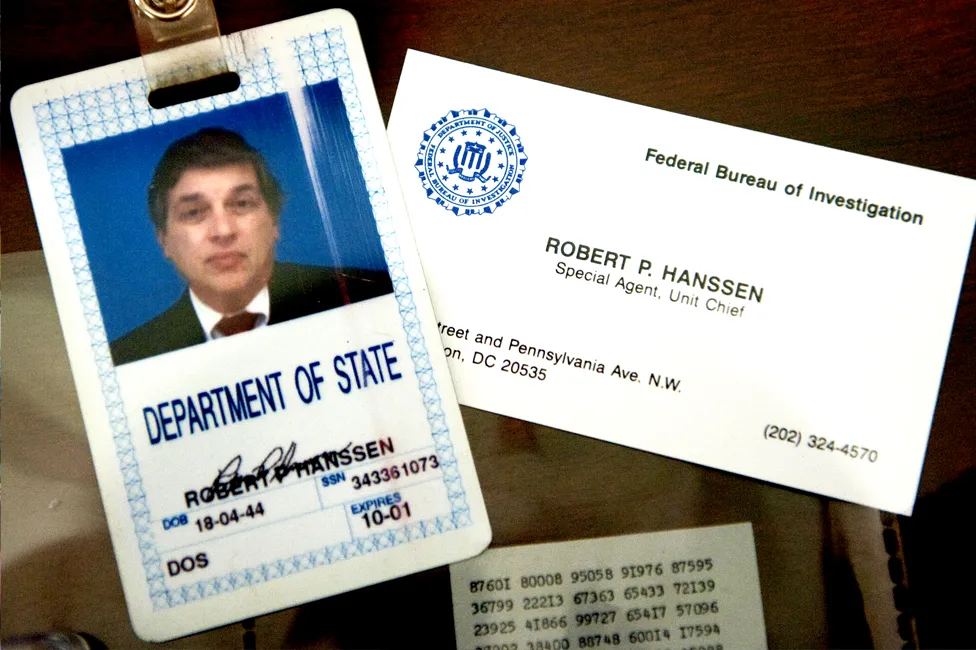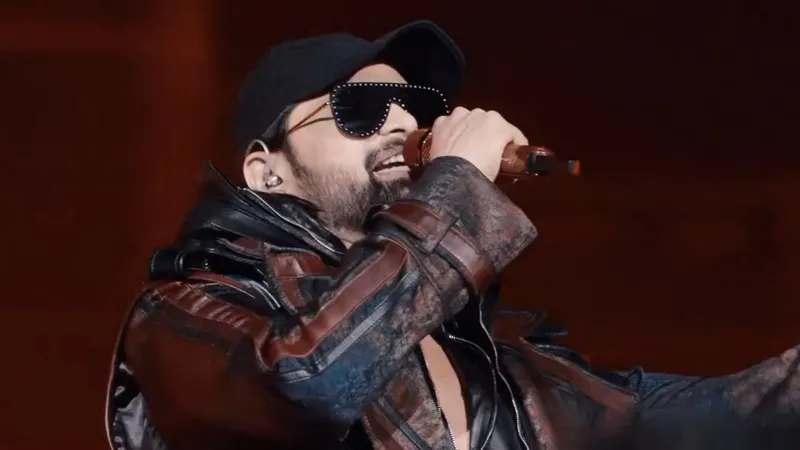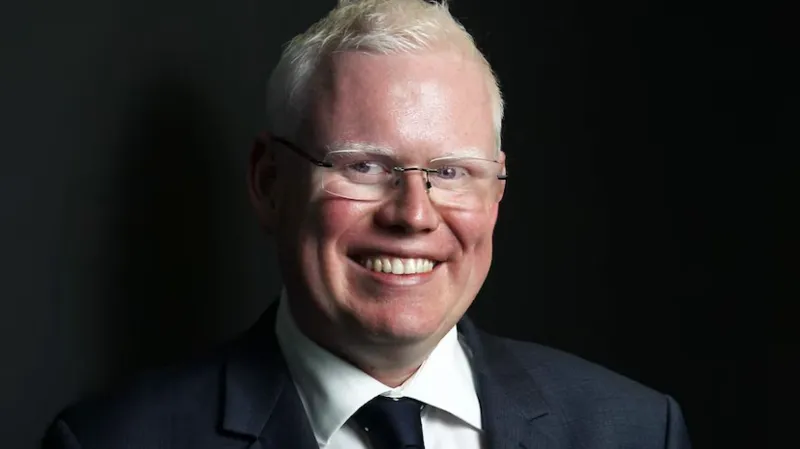Robert Hanssen: The fake job that snared FBI agent who spied for Moscow
Robert Hanssen was one of the most damaging spies in the history of the FBI. The former US agent, who has died in prison, leaked top secrets to Moscow for nearly 20 years - betrayals that the agency says cost lives. It took 300 agents to finally bring him down. Two of them who played a central part tell us how they did it.

In December 2000, FBI agent Richard Garcia had a curious visit from a colleague overseeing the Russia desk.
"He asked, 'Do you know a guy named Robert Hanssen?'" Mr Garcia recalled. "I said, 'No'."
The official responded: "Good. Because you're about to."
A few months later, in part thanks to Mr Garcia's covert work, the whole country would as well. Hanssen's arrest in February 2001 sent shockwaves through the intelligence community and the extent of his double life burst on to the front pages.
More than two decades later, on Monday this week, authorities announced that he had been found unresponsive in his cell at the maximum-security prison in Colorado where he was serving a life sentence. He was 79 and is thought to have died from natural causes.
Mr Garcia, now 70 and retired from the FBI, reacted tersely to the news. "Good riddance," he said.
Deadly acts of betrayal
Hanssen had studied Russian in college and began working for the FBI in 1976. Within a decade, he was double-crossing the bureau. Starting in 1985, Hanssen operated as a destructive mole within the US government, selling top secret documents to the USSR and Russia, and compromising the identities of undercover spies.
According to the 100-page affidavit outlining his crimes, Hanssen's espionage resulted in the arrest and imprisonment of three US sources and the execution of two more.
Some of the top-secret documents that Hanssen handed over included a US intelligence assessment of Soviet attempts to gather intelligence on American nuclear programmes. Hanssen gave information to the KGB, and later its post-Soviet iteration, the SVR.
In exchange for his deceptions, the Russians paid Hanssen $1.4 million - $600,000 in cash and diamonds, and another $800,000 placed in a bank account.
Hanssen operated under the radar for so long due to his old-school espionage methods. He relied on "dead drops", a method of physically leaving materials for his handlers to discover. He chose mundane sites throughout the suburban Virginia neighbourhoods that surround Washington to deliver the stolen intelligence.
His handlers in Moscow did not know his identity. He went by the alias "Ramon Garcia", of no relation to Robert Garcia who mused the coincidence might have irked Hanssen once they met.
His activities continued long after the Berlin Wall fell and the USSR disintegrated. He was attempting to communicate with the Russians right up until the moment of his arrest.
But a series of intelligence breakthroughs eventually put the FBI and the US intelligence apparatus onto his tail.
Identifying the mole
US intelligence officials had suspected a spy in their midst since the 1990s, but it took a few years to zero in on Hanssen.
Then a Russian asset working for the US obtained the Russian dossier on their man in Virginia. Inside US intelligence officials discovered a recording of a phone call Hanssen made to his handlers, as well as fingerprints left on trash bags used for dead drops.
By November 2000, they had their man. But now they had to prove it.
The FBI hatched a plan to place Hanssen under surveillance by transferring him out of the State Department where he worked and creating a bogus job at the Bureau where operatives could monitor him.
"What we wanted to do was get enough evidence to convict him, and the ultimate aim was to catch him in the act," Debra Evans Smith, a former deputy assistant director of the Counterintelligence Division, recalled in an FBI summary of the case.
That's where Mr Garcia came in.
On 8 December 2000, the section chief for the FBI's Russia desk dropped by to fill him in on Hanssen's subterfuge.
Mr Garcia, an experienced undercover operative, was to be Hanssen's fake superior, a very bureaucratic boss.
"He hated me, let's put it that way," Mr Garcia recalled. "I had to basically slow him down without it getting too ridiculous."
Only a few FBI employees knew about the spy in their midst.
A pivotal Palm Pilot
Mr Garcia recruited Eric O'Neill, a 26-year-old undercover operative with a knowledge of hacking, to pose as Hanssen's administrative aide.
"This was one of the most major events in my life, going undercover at a relatively young age and going up against the most damaging spy in US history," Mr O'Neill told the BBC.
Over the next few weeks, the two got to know each other well - though one was covertly investigating the other. At one point, Mr O'Neill even accompanied Hanssen's family to church.
Mr O'Neill described his target as a narcissist with a huge ego. "He wanted to be a mentor. He wanted to impart all his knowledge on someone."
Over the course of the investigation, Mr Garcia would take Mr Hanssen (whom he described as a "gun nut") to a shooting range while agents conducted searches, including one of his car where agents uncovered top secret documents.
One day, he lured him out of his office to a shooting range while Mr O'Neill frantically copied the contents of his Palm Pilot - a precursor to BlackBerrys and smartphones.
In Mr O'Neill's telling, he replaced the device just in time before Hanssen returned.
If this sounds like something out of a Hollywood movie, it is one - Mr O'Neill's story was made into a 2007 espionage thriller called Breach, starring Ryan Phillippe, Chris Cooper and Laura Linney.
Capture and sentencing
By February 2001, 300 agents were working on the case, according to the FBI.
They laid in wait for Hanssen to attempt another dead drop and eventually he did.
Hanssen was arrested in February 2001 at Foxstone Park in Virginia and charged with espionage. He pleaded guilty to 15 counts and was sentenced to life in prison without the possibility of parole.
FBI director Louis Freeh called Hanssen's betrayal "the most traitorous actions imaginable against a country governed by the rule of law".
The case threw a wrench into relations with its Cold War rival and President George W Bush expelled numerous Russian diplomats.
Hanssen was sent to prison in Florence, Colorado, where he remained for over two decades until his death this week.
Mr O'Neill went on to write a book about the case, Gray Day, and is now a "keynote speaker/spy catcher", according to his website.
He tried for years, without success, to interview Hanssen for the book. After spending weeks shut in a small, bureaucratic office with Hanssen in the early 2000s, prison officials refused to let him spend even a moment in the spy's cell.
When he heard Hanssen had died, Mr O'Neill regretted not pushing harder to get it.
"I would have asked him, why did you do it? Because it's something that I am fairly certain I know, but something that he has refused to ever tell anyone."
Mr Garcia has his theory why Hanssen betrayed his country - ego. "He felt he was god, and he was gonna be able to control the United States and Russia."
He ranks Hanssen as the most destructive spy in US history.
"For the damage he did for the US and Russia, for people who died as a result of the information he gave up. For doing it for so long. It was just amazing that it happened the way it did."
-bbc







